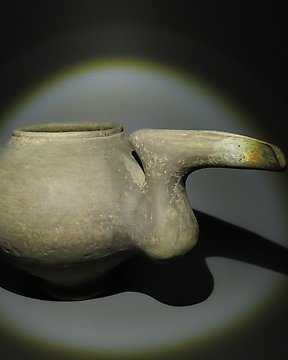
Amlash Terracotta Vaso con beccuccio appendicolare. Inizio del I millennio a.C. 29 cm D. Raro e unico
N. 85843145

N. 85843145

Idol Figure.
Valdivia, Ecuador.
3rd Millennium BC.
Terracotta.
8 cm Height.
PROVENANCE: Romy Rey private collection, London, United Kingdom.
CONDITION: Missing lower extremity, good condition.
DESCRIPTION:
The Valdivia culture arose in one of the most arid segments of the southern Ecuadorian coast, mainly in the Santa Elena Peninsula, although remains of the culture have also been found further inland. Vegetation grows mainly along the banks of the single river that flows through the area, but the cold waters of the Humboldt current nourish a rich ecosystem along the Pacific coast that includes a wide variety of seaweed, fish, and shellfish.
The origins of the Valdivia culture remain a mystery, especially given the major differences between this group and the previous inhabitants of the region, who were basically hunter-gatherers. Similarities in ceramic crafts suggest the possibility of links to earlier groups inhabiting the Amazon region, across the Andes Mountains. The Valdivia culture opened the way for the later development of the Machalilla culture, and many of its cultural elements – especially those related to innovations in ceramics – spread rapidly into neighboring areas.
The Valdivia culture is noted for being one of the first American cultures to produce large quantities of ceramics. They mainly fashioned cooking pots, bowls, and dishes, always with an open neck and a concave base. A variety of techniques such as modeling, incisions, and embossing were used to decorate these vessels with geometric motifs, usually after they had been polished. The Valdivia tradition is also known for its figurines, which were initially made from stone but later in ceramic. Most of these represent women in different stages of life such as puberty, pregnancy, and childbirth. The importance of personal adornment to this culture is reflected in figurines with bezotes (lip jewelry), necklaces, and earpieces. These items were generally made from the shells of sea creatures such as the bivalve mollusk Spondylus and the sea snail Strombus, which would later hold great ritual significance for Andean peoples.
Notes:
The seller guarantees that he acquired this piece according to all national and international laws related to the ownership of cultural property. Provenance statement seen by Catawiki.
The seller will take care that any necessary permits, like an export license will be arranged, he will inform the buyer about the status of it if this takes more than a few days.
The piece includes authenticity certificate.
The piece includes Spanish Export License.
Come fare acquisti su Catawiki
1. Scopri oggetti speciali
2. Fai l’offerta più alta
3. Paga in tutta sicurezza